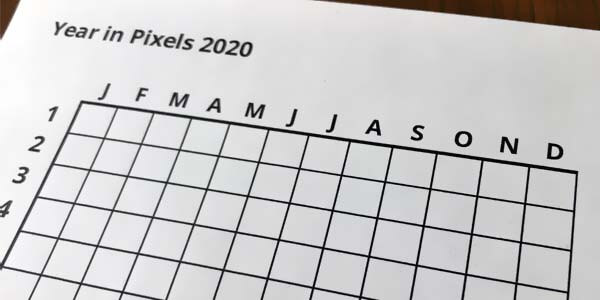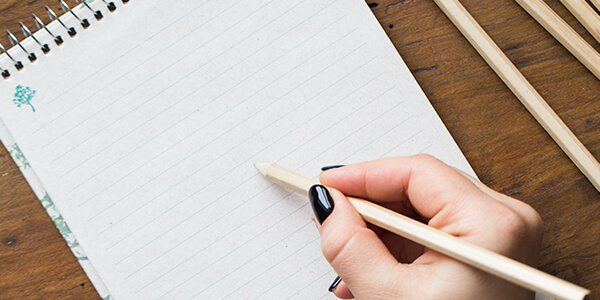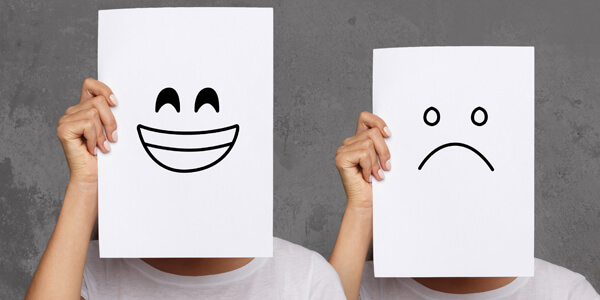A mood calendar is a simple but effective way of keeping track of your mood. It can help you identify patterns and establish a better understanding of your wellbeing. The great thing is that it can be done with little effort. And the results are not just mind-blowing, but beautiful. Find out how to keep a mood calendar and what you should do before you start.
What is a mood calendar?
First things first. When we are talking about a mood calendar here, we are talking about visualizing your mood in a calendar-like diagram. We recommend to use two different types:
1) “Year at a Glance” – similar to a common calendar

2) “Year in Pixels” – a matrix of months (horizontal) by day of month (vertical)

Both types have in common that every single square (aka pixel) represents your (average) mood for one day. The “Year at a Glance”-calendar is for discovering mood patterns that correlate with weekdays (e.g. “I’m feeling down especially on Sundays.”). The “Year in Pixels” format is great for discovering mood patterns that correlate with the days of the month (e.g. “I’m feeling good especially at the end of a month.”). Depending on what you prefer, choose one or the other or both.
Keeping a mood calendar is not just a flash in the pan
A mood calendar develops its full potential only if you keep on tracking your mood daily. You will probably just need a few seconds every day, but you need to do it at least once a day. That is something you should keep in mind during preparation!
We will guide you through the preparation steps to decide on the format, scope, and structure of your mood calendar. There are a lot of ways and options to keep a mood calendar. Your task is to find the perfect combination of options for you. To achieve that, always keep the following question in mind: “What is the best choice, so I will keep at it?”. The worst mood calendar is the one that is not kept at all. Better start with a simple and easy one and if you feel like it, you can extend its scope by the time.
An analog or digital mood calendar

There are a few things to consider when deciding on the format of your mood calendar. First of all: Do you prefer pen & paper over an app on your phone? Both options come with their advantages and disadvantages.

Starting with pen & paper is a simple, straight forward way of creating a mood calendar, and it probably doesn’t get more personal than that. On the other hand: Using an app means that you will always carry your mood calendar with you and can add or update it any time. Apps usually come with supporting features like reminders and reports at no additional effort. If you are going to opt for an app, pay close attention to the privacy policy it uses. You probably don’t want your data to be shared with any third party. Check out Moodistory (iOS / Android) if you want to know more about what an app has to offer.
Deciding on the scale of your mood

“On a scale of X to Y, how are you?” is the basic question you are going to answer every day. Usually, the scale is divided into equal parts of negative & positive values (moods) and optionally a neutral (neither positive nor negative) mood. So, firstly, you should clarify if you even feel like there is a neutral mood in your mood spectrum. Or, if you can always see a tendency towards a rather positive or negative mood.
Once you’ve cleared that up, you need to choose the correct scale. If you are going to use a neutral mood, you need to choose an odd scale (3, 5, 7, 9, etc.). If you don’t want to use a neutral mood, you need to choose an even scale (2, 4, 6, 8, etc.).
For example, a scale of 6 will provide you with 3 values for a negative mood (1, 2, 3) and 3 values for a positive mood (4, 5, 6). There is no neutral mood. Clearly, if you would choose a scale of 7, you will have a neutral mood (being 4).
So, the last question is: How many levels of “positivity” and “negativity” would you like to track?
We recommend starting with a rather low scale (something between 4 and 7). Use it for a few days. If you’re having a day that doesn’t fit, you can still alter the scaling then. If you’re going to use an app, make sure that changing and setting the scale are supported, like in Moodistory.
Choosing the colors

Once you have a scale, you need to assign a color to every single value. If you are using pen & paper, you’re going to need a nice set of colored pens. Play with color combinations and see for yourself which ones you like most.
If you are using an app, you can usually choose from a set of predefined color combinations and customize them to your taste.
Effort vs. scope
The more information you record about your mood, the easier it will be to establish a better understanding of it. But more information usually comes with more effort – especially if you’re keeping a mood calendar with pen & paper. So, think carefully about what else you would like to keep track of (e.g. medication, sleep, activities, events, period, thoughts & notes). Also, keep in mind that once you discover a mood pattern, you will want to know more about the “why”. Try to identify those characteristics that will help you remember the situations when you were in that mood. An app usually has a thought-through structure that guides you through this process.
Plan for keeping your mood calendar
Although keeping a mood calendar doesn’t take a lot of time, it’s important to make it a habit and make it part of your daily routine. So, before you start, think about a time of the day when you will usually be able to reflect on your mood. Consider setting a reminder in order to stick to the plan.
A nice trick is to reward yourself every 5 days that you’ve been tracking your mood. Especially in the beginning, such things can be very helpful!
Preparation checklist

Now that we went through the cornerstones of the mood calendar, go on and create your basic setup. Here’s a checklist that you should be able to answer if you are well-prepared:
- Are you going to use an app or pen & paper?
- On which scale are you going to evaluate your mood?
- Which colors are you going to use?
- What in addition are you going to keep track of?
- At which time are you going to update your mood calendar daily?
If you could answer all of these questions, you are good to go, and you can start right away! You are going to learn a lot about yourself and once you’ve made it a habit, you’re going to love it! Guaranteed!
Let’s go! 🙂

